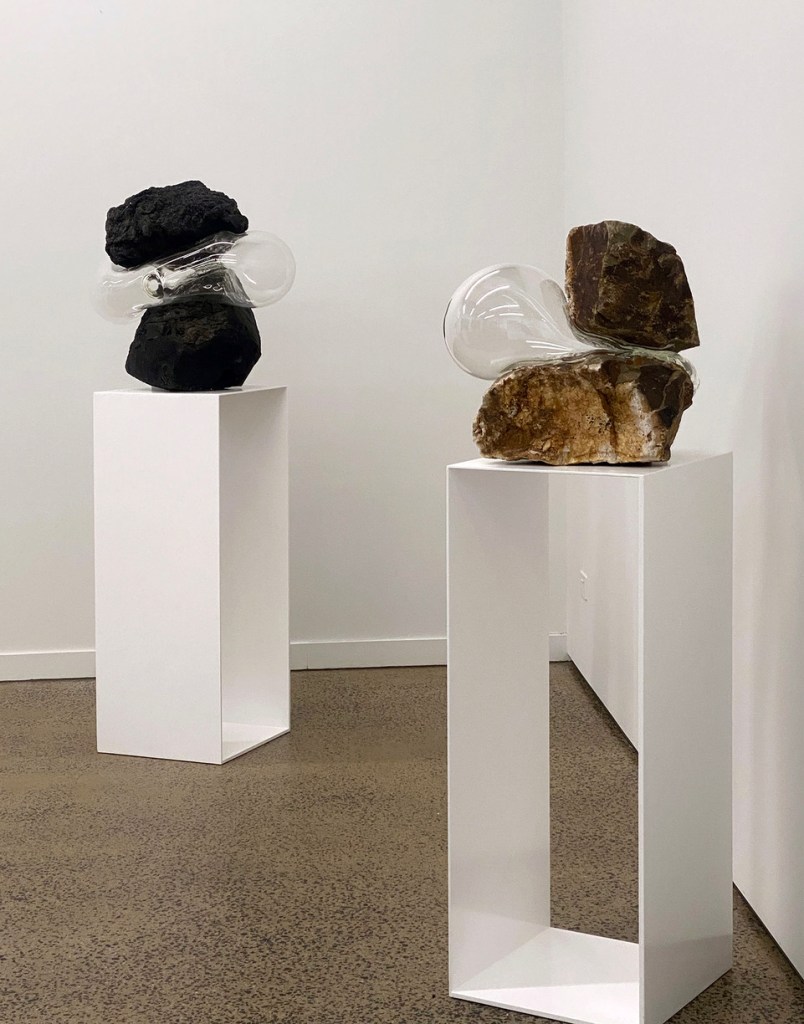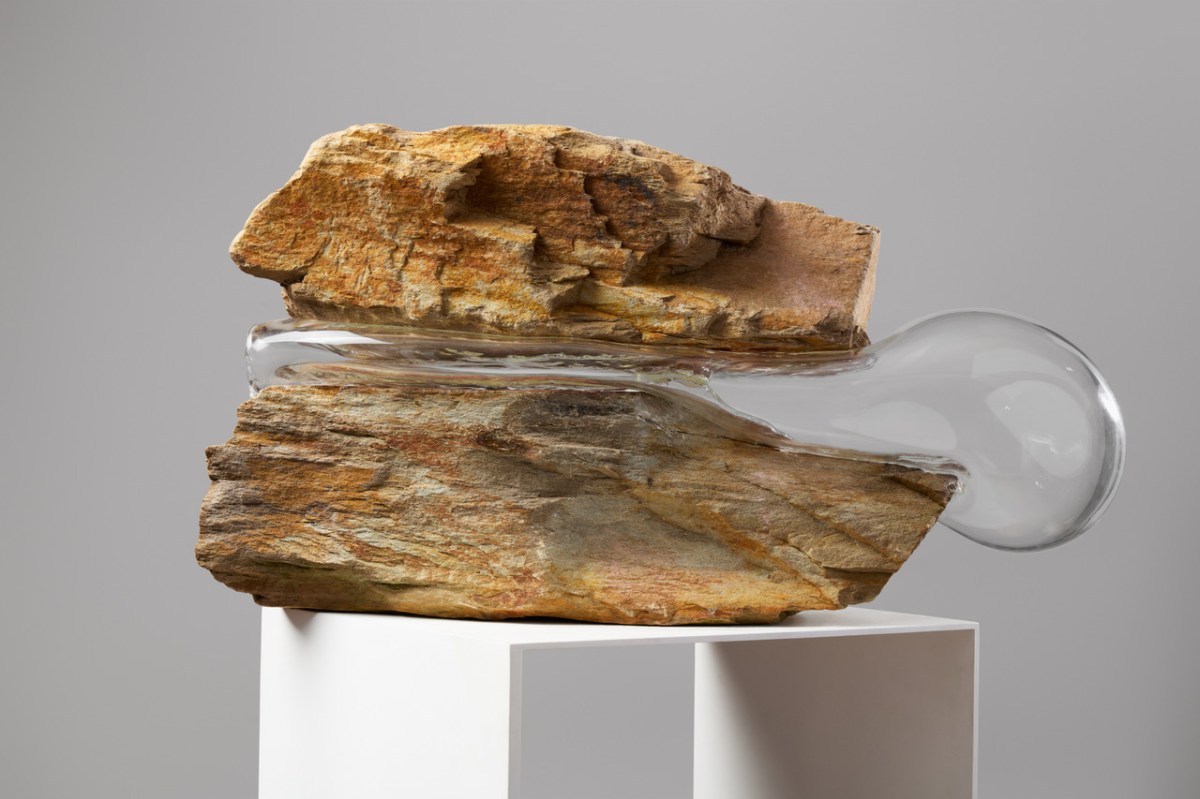Sometimes the most important thing connecting objects and people is the space between them, the air they afford each other, like breathing space. In the new Collingwood (Victoria) location of a recently reopened Sarah Scout Presents, alongside works by Anna Finlayson and Christian Thompson, Simone Slee’s Rocks holding up presents a series of works that use glass to mould what might be called the breath of a rock.
Slee’s works in the series have an anthropomorphic quality, suggestive of cheeky faces blowing bubbles or tongues spilling out that the artist has sculpted with clear blown glass. The works consist of two pieces of rock balanced vertically with a section of rounded glass holding up the top piece. The rocks range from densely black and red scoria to Pyrenees quartz, bluestone and sandstone. They are sourced from the lands of Dja Dja Warring, Eastern Maar, Gunditjmara and Wurundjeri people. This diversity gives each work a distinct geological character.
By combining the rocks with the delicacy and transparency of glass, Slee plays with ideas of balance and space. The bubbling effusions seem to materialise the gap between the rocks, like an underground reservoir or light-filled cavern. But they also insert space between the rocks, pushing between them like alien intrusions in otherwise familiar terrain. The glass parts are both squeezed and released, compressed by and buoyant against the materials the contrasting qualities of which play against each other.
Wedged between the rocks, the glass bulges appear both in the role of structural support, holding the upper rock in the air, and seeming to nearly overturn the sculpture, as in Rocks holding up #14 and Rocks holding up #10. Slee’s work mobilises opposition: the sense of stability and precarity of the sculptures, their lightness and weight, both collapsing and inflating. The contrast of textures between the materials is enhanced by the rough glass surface where it contacts the rock from above and below.
This series continues a 2019 series working with granite that contained a column ‘holding up’, a brick ‘holding together’ and a horizontal slab ‘holding up’ as well as images associated with the video work Rocks happy to help: hold up, hold down (2017). Shelley McSpedden traces this ongoing practice of contrasting materials to Make a Sculpture, Watch it Fall Down (2005). The progressive modification in Slee’s approach to unlikely combinations is developed by the latest Rocks holding up series.
Specifically, the ratio between rock and glass has become steadily less stable, with Slee more assertively challenging the material limitations. This is notable in the shift in titles, from a 2017 series Rocks and Things, Happy to Help (2017) to works that both ‘hold up’, ‘hold down’ and ‘hold together’, and to Rocks holding up. The sense of holding up afforded by these objects is one of tolerance, reluctantly bearing the weight or straining to maintain balance. The mood and relationship between the parts of the works is more uncertain, a bit strained.
This uncertainty is visible in the vase-like openings in each of the glass components, round fish-like mouths that remain unsealed and expectant. Unlike earlier works, where the glass bulbs seem to ooze from the rocks, the bubbles in Rocks holding up are unlikely inflations, deep intakes of breath rather than exhalations. This makes the upper rock a sort of heavy diaphragm the weight of which sometimes squeezes air sideways, as in Rocks holding up #13, #16 and #12. Other works do not so much lift the upper rock as encircle a point of contact between the two layers, as in Rocks holding up #15 and #10.

Presents.
Despite the variable protrusions, each of these works has a definitive top and bottom, with the layer of glass between working as a sort of point of transmission or conduit. The clarity of the top and the bottom repeats the support of the plinth, raising the upper rock to a point of special focus. It is as if we are invited to look underneath something we ordinarily could not, a sculpture or material baring its interior not as depth, but in the form of new surfaces, both rough and smooth.
Another point of contrast lies in the way the rock and glass interact with light and space respectively. The rock’s craggy density absorbs and holds light, while glass refracts and reflects it, forming white lines from the fluorescent lighting of the gallery space. But there is a central emptiness to the works. It is strange to encounter such substantial parts of a work that you can see through without spoiling the integrity of the whole. Slee creates a split that adds rather than subtracts from the object.
Read: Exhibition review: Adrian Cox, Catriona Secker, Katie Gamb, Ginklet, Beinart Gallery
Nevertheless, some of Slee’s works are best viewed frontally, like Rocks holding up #11, which evokes a canine head with a protruding bulbous, swollen tongue. Such lively associations are possible in viewing these works, which can also be read as delightfully comic propositions, positing an unlikely marriage of materials and observing the effects of pressure. Their playful quality consistently offers an encounter that is personal and creaturely, and at the same time impersonally absorbed in the surfaces, textures and material contrasts.
Simone Slee: Rocks holding up will be exhibited at Sarah Scout Presents until 1 June 2024.





